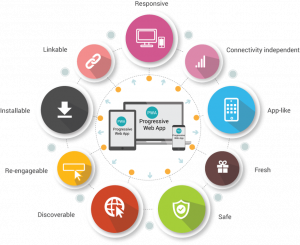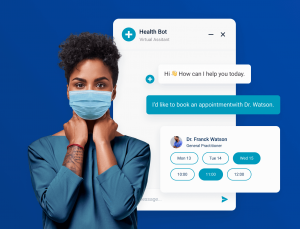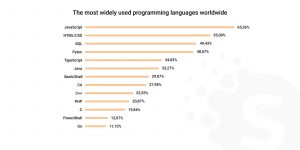![Top 10 Web Development Trends in 2023-2024 [Updated]](https://www.programmingassignment.net/wp-content/uploads/2023/04/development-trends.jpg)
Top 10 Web Development Trends in 2023-2024 [Updated]
When it comes to web development, savvy developers are constantly looking for new ways to adapt to the industry’s constant change. Nobody could have predicted the state of the web 20 years ago, so who knows what the next few decades may bring.
Undoubtedly, more opportunities will arise as trends develop. Following the most recent trends in web development may one day lead to you being hired for a position that doesn’t even exist yet.
In this article, we’ll discuss the latest programming trends you can expect to dominate in 2023-2024. Some of them already exist and will become even more prevalent in the upcoming years. So, let’s not waste time and start!
Latest Web Development Trends for 2023-2024
1. Progressive Web Apps (PWAs)
Simply being responsive is no longer sufficient. Today’s sites must be progressive.
Progressive Web Apps (PWAs) are web applications that simulate the appearance and feel of native mobile apps while still being accessed via a web browser. PWAs are intended to function offline, load quickly, and offer an unmatched user experience across various devices. As a result, they adjust to the screen size, browser, and device specs of the user.
This latest trend in web development is not new. Companies like Uber, Starbucks, and Pinterest already use PWAs to improve user experiences. However, it is gaining more popularity nowadays because it provides many of the advantages of native mobile applications without the need for a separate app store.
Undoubtedly, CSS, React, HTML, WebAssembly, Angular, and JavaScript will continue to be utilized to build PWAs.

2. Visual assistants and AI chatbots
Virtual assistants (VAs) and AI chatbots are probably some of the most influential technologies nowadays because they offer companies a quick and easy way to interact with clients.
These technologies can complete transactions, offer customer service, and provide responses to customer inquiries, automating monotonous operations. But that’s not all. Chatbots with AI assistants like Siri, Alexa, and Cortana can self-learn, conduct analytics, collect data, and solve complex tasks.
VAs and AI chatbots, including voice bots, are already being used by numerous well-known B2C businesses, so you can anticipate these web development trends gaining even more momentum this year.

3. Single-page applications (SPAs)
Web applications known as single-page apps (SPAs) not only load a single HTML page but also dynamically update the content when the user interacts with the application.
SPAs are developed using JavaScript frameworks like Vue.js, Angular, and React, simplifying the development of complex and interactive interfaces. Due to these advantages, both site visitors and developers profit from this latest trend in software development.
Actively utilized by Google and Facebook, SPAs are getting increasingly popular among the developer community because they consume less server space and offer a quick, responsive user experience comparable to that of a native mobile app.
As users expect quicker and easier app experiences, we can anticipate the SPA trend to continue.

4. Content personalization with machine learning
The next one of the software development trends we’ll discuss in this article impacts users’ work on the internet, even if they don’t notice it.
The core goal of machine learning (ML) is to enhance user experience, improve search capabilities, and automate tasks without the direct involvement of developers. The software allows for the personalization of data, the definition of patterns, and making decisions with automatic work improvement.
Netflix and Alibaba use ML to better respond to user requests. Each user is given an individual identification, which significantly differs from targeting. Instead of considering the previous requests, the software offers material and outcomes tailored to a specific person.
The examples are numerous. This year and beyond, machine learning will continue to be a key component of web services, but businesses will have to adjust the technology to their needs. Users won’t be aware that algorithms are being used by the website or application owners, but they will undoubtedly be satisfied, resulting in increased engagement and conversions.
5. Responsive design
As more than 58% of all web traffic worldwide comes from mobile devices, and they account for roughly 75 percent of all e-commerce sales worldwide, creating mobile-friendly websites has never been so crucial. That’s when responsive design comes into play.
Responsive design is one of the programming trends that involve the creation of web pages that automatically adjust to the resolution and size of the user’s device. Flexible grid layouts, images, and other elements that scale and adapt depending on the device are used to achieve this.
One of the many benefits of employing responsive design is a more seamless user experience, accessibility across a wide range of devices, and an improved brand reputation.
Of course, a lot of developers have used this approach for years. Yet the meaning of the notion of mobile-friendly changes all the time. These years, this will entail, among other things, incorporating biometric authentication methods like voice recognition or fingerprint scanning and using geolocation to provide customers with more tailored experiences.

6. JavaScript frameworks
In 2023 and beyond, developers will continue to favor JavaScript frameworks like React, Vue, Gatsby, and Angular because they offer a robust set of tools for creating complex, interactive online apps. These frameworks simplify managing application states, building reusable components, and handling routing and navigation. Because of this, they are frequently used to create single-page applications (SPAs) and all other dynamic web applications and are definitely a part of future web development.
Below is a Statista report. As you can see, JavaScript holds the top spot.

By the way, if you ever get stuck on a JavaScript or Java problem, you can always give a professional Java assignment help service a try. Our experts use all these frameworks to deliver reliable custom-made solutions that clients really enjoy.
New Trends in Web Development for 2024
1. VUI & voice search
According to Statista, the voice recognition market is projected to soar from $10 billion in 2021 to $50 billion in 2029, with a Compound Annual Growth Rate (CAGR) of 23.7%. The integration of generative AI into voice search is not merely a potential development; Google has already incorporated it into Assistant.
Given the above, aspiring web developers should now prioritize optimizing every application they work on for voice search and navigation, especially mobile apps. This is no longer an optional feature—it has become one of the essential new trends in programming.
2. Static site generators
Static site generators transform plain text, typically stored in files rather than databases, into websites. Platforms like Jekyll offer particular advantages in specific scenarios. These include enhanced security, speed, simplified deployment, and the ability to manage sudden increases in website traffic. However, they lack real-time content or user-generated content, such as comments, which are considered essential on the modern web.
As Content Delivery Networks (CDNs) and APIs increasingly shape the future of web programming by facilitating the deployment of content and templates, many developers see static site generators as an intriguing area to monitor in the coming years. By separating templates and markup from the traditional “full-stack” approach, static site generators may regain prominence as one of the noteworthy web development future trends.
3. Yarn package manager
Package managers are widely utilized tools, particularly within the frontend JavaScript communities, facilitating the installation, updating, configuration, and removal of code modules within applications. They achieve this functionality by interfacing with a registry of code modules and managing the dependencies typically associated with these modules.
The most prevalent JavaScript package managers include NPM and Bower. However, Meta, Exponent, Google, and Tilde have collaboratively developed a novel package manager—Yarn.
Here’s what is so special about it: Retaining access to the NPM and Bower registries, Yarn aims to address the challenges Meta encountered with NPM, particularly those related to security, performance, and consistency.
For instance, with NPM, depending on the sequence of module installations, developers may encounter differing versions of a particular module in their local environments. This discrepancy can lead to inconsistencies across different developer machines. To mitigate such issues, Yarn utilizes lock files to associate modules with specific versions within projects, ensuring uniformity across all developer environments.
Ranked fifth in the “Most Used” category of the 2023 StackOverflow Developer Survey, Yarn is expected to continue its upward trajectory.
4. New in web development: Angular 18.0
In the years following 2016, Angular experienced significant updates, marking a departure from its earlier versions. Google’s JavaScript frontend framework underwent a complete redesign, harnessing the capabilities of JavaScript ES6 and adopting TypeScript for application development. This transition also involved a shift towards a component-driven architecture, posing challenges to the community.
Nowadays, Angular follows a more organized schedule for its releases, guaranteeing compatibility with previous versions while implementing consistent updates. The forthcoming version, Angular 18.0, is scheduled for release in May 2024.
Final thoughts
Apart from the above, the latest software development trends will continue to include an emphasis on accelerated web pages, optimized voice search, serverless architecture, dark mode standardization, Motion UI, blockchain technology, ambient design, agile development, cloud-based development and deployment, and an increased focus on native cybersecurity. Moreover, WordPress development is anticipated to advance and grow in popularity as an open-source, adaptable, and user-friendly platform for website design and management.
Other innovations expected to become the new web development trends these years include headless CMS and augmented reality (WebAR).
All of these trends are anticipated to enhance the usability, performance, and accessibility of web apps and websites, making them more engaging, effective, and secure.
Need help with programming assignment? Let professionals do the job!
Our hand-selected experts in Java, JavaScript, Rust, C++, C, PHP, Python, and other programming languages have a solid knowledge of Computer Science, years of professional experience, familiarity with programming best practices, understanding of the source code execution nuances, and a focus on providing top-quality code by the client’s deadline.
What’s more, you can always request that our developers comment on every function and method in your code and deliver a manual on running it.
Contact us for a free consultation today!





